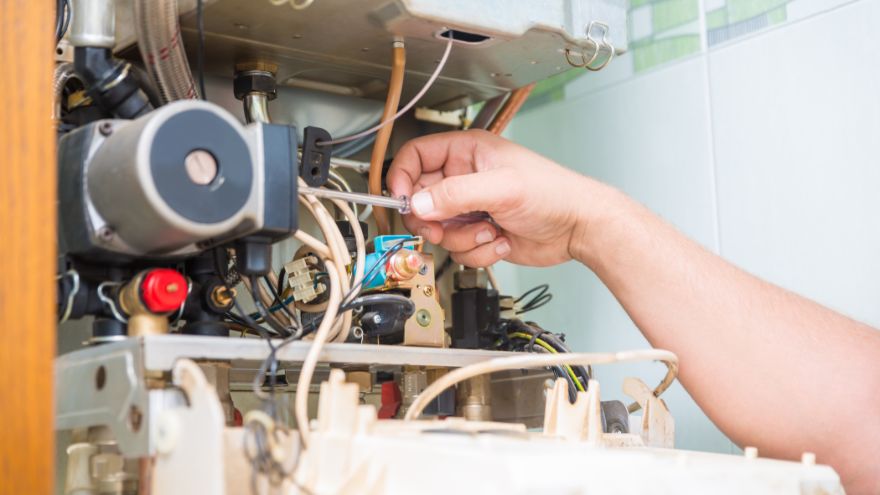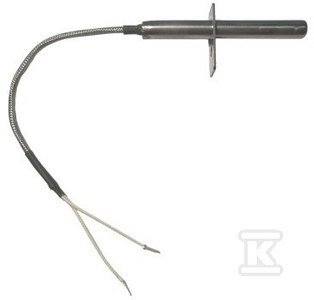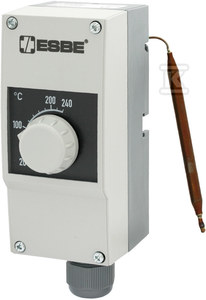The exhaust gas temperature sensor is an extremely important element of the entire heating system, ensuring the ability to respond immediately to any irregularities. Designed to record even the smallest changes in exhaust gas temperature. His role cannot be overestimated. It's definitely worth getting to know this device better!

Check exhaust gas temperature sensors at the Onninen wholesaler
Appropriate exhaust gas temperature in the furnace - what to remember?
The appropriate exhaust gas temperature in the chimney depends on two main factors - the type of fuel and the type of heating device. Older type boilers have different requirements in this respect than modern type devices, which is why the issue of exhaust gas temperature is completely different. It is much higher, ranging from 230 to 350 degrees Celsius. Taking into account such an exhaust gas temperature, one might think that it is too high, but in these boilers it was absolutely safe for the chimney, as it ensures uninterrupted operation in dry mode. This is because moisture did not have the conditions to condense on the walls. At the same time, a strong chimney draft was guaranteed. On the other hand, in such devices the combustion process was not specifically controlled, which had a negative impact on the boiler's operating efficiency.
 This is different in modern class 5 boilers, which are both economical, i.e. cost-effective, and environmentally friendly. Thanks to this, they are able to optimally use the heat contained in the fuel. However, this has an impact on the exhaust gases, specifically on their lower temperature (100-110 degrees Celsius). In principle, this is good because the heat does not escape outside, but heats the rooms appropriately. However, lower temperatures affect the chimney because water vapor condenses, causing corrosion. What's worse, the chimney draft is weaker if we compare it to exhaust gases at a higher temperature. So we can see that lower values are appropriate, but it has its drawbacks. So the question arises: how to make the exhaust gas temperature increase when we need it. We will deal with this issue in the next paragraph.
This is different in modern class 5 boilers, which are both economical, i.e. cost-effective, and environmentally friendly. Thanks to this, they are able to optimally use the heat contained in the fuel. However, this has an impact on the exhaust gases, specifically on their lower temperature (100-110 degrees Celsius). In principle, this is good because the heat does not escape outside, but heats the rooms appropriately. However, lower temperatures affect the chimney because water vapor condenses, causing corrosion. What's worse, the chimney draft is weaker if we compare it to exhaust gases at a higher temperature. So we can see that lower values are appropriate, but it has its drawbacks. So the question arises: how to make the exhaust gas temperature increase when we need it. We will deal with this issue in the next paragraph.
How to increase the exhaust gas temperature?
Sometimes it is worth increasing the exhaust gas temperature by increasing the draft in the chimney. There are several ways to do this. One of them are special mounted covers, whose main task is to cover the outlet in such a way as to prevent reverse suction of air and exhaust gases. If we have exhaust or smoke ducts, a good solution that increases the draft in the chimney, and thus the temperature of the exhaust gases, is a "fireman" type cap. This is facilitated by its design, which eliminates the negative pressure phenomenon. This way, exhaust gases escape more easily from the chimney to the outside.
Increasing the exhaust gas temperature is also possible thanks to appropriate fans that regulate the operation and power of the chimney. Such devices artificially produce thrust. However, remember that the temperature increase should be under control, which is helped by exhaust gas temperature sensors. It analyzes it, which allows you to reduce chimney losses, and which has a positive impact on both the efficiency of the boiler and savings on fuel consumption. The exhaust gas temperature sensor is therefore an absolute necessity.
How to recognize a damaged exhaust gas temperature sensor?
However, it may happen that the temperature sensor is damaged, so it is worth knowing how to recognize the basic symptoms of this condition. Especially since in the case of exhaust gas temperature sensors there are situations where the damage may be the beginning of a larger failure. However, it is often necessary to replace it with a new one in order for the exhaust emission readings to be correct. Recognizing a faulty exhaust gas temperature sensor can be crucial to maintaining the safety and efficiency of your heating system.
 To determine this, we need to monitor the operation of the furnace, because most often it is the temperature of the exhaust gases that allows us to notice that something is wrong. It is unstable. Let's read the exhaust gas temperature directly from the furnace display or control panel to exclude irregularities. A visual inspection of the sensor is equally important, because sometimes a sensor failure is visible at first glance and is known to result from mechanical damage, such as a crack in the housing.
To determine this, we need to monitor the operation of the furnace, because most often it is the temperature of the exhaust gases that allows us to notice that something is wrong. It is unstable. Let's read the exhaust gas temperature directly from the furnace display or control panel to exclude irregularities. A visual inspection of the sensor is equally important, because sometimes a sensor failure is visible at first glance and is known to result from mechanical damage, such as a crack in the housing.
In the case of exhaust gas temperature sensors, comparative measurements are also helpful, provided, of course, we have access to measurement tools. This allows these values to be compared, determining whether sensor failure is present. Sometimes it is necessary to consult a qualified service technician who will thoroughly examine the problem and propose appropriate solutions. He will also advise on other issues, such as exhaust gas recirculation temperature, exhaust gas treatment system, help with the particulate filter, etc.
Check exhaust gas temperature sensors at the Onninen wholesaler
Where to install the exhaust gas temperature sensor - which is the best?
There are different types of exhaust gas temperature sensors, but regardless of which one we choose, each of them should be installed in the same places. One of them is located directly on the chimney section. This is definitely the most effective installation location, because the sensor can precisely monitor the temperature of exhaust gases leaving the boiler or furnace. It is also advisable to place it close to the exhaust gas outlet, so that the temperature measurement immediately after leaving the heating system will be very accurate. Another good location is the ventilation system, but it should be noted that this is not always possible.
Correct installation of the exhaust gas temperature sensor - step by step
As you can see, the role of exhaust gas temperature sensors is crucial, but they must be installed in the right place for them to work properly. Correct installation is equally important. Much, of course, depends on the model of the sensor and the heating system, but the sequence of actions is always the same.
 The first and most important thing is safety, i.e. turning off the power supply to the heating device. Once we have done this, let's choose an appropriate place for installation, using the tips we provided in the previous paragraph. An important step is to prepare the installation site. Let's make sure it is clean and free of other inconveniences. If everything is in order, we can start the physical assembly, attaching the sensor according to the manufacturer's instructions. It is important that it is stably mounted.
The first and most important thing is safety, i.e. turning off the power supply to the heating device. Once we have done this, let's choose an appropriate place for installation, using the tips we provided in the previous paragraph. An important step is to prepare the installation site. Let's make sure it is clean and free of other inconveniences. If everything is in order, we can start the physical assembly, attaching the sensor according to the manufacturer's instructions. It is important that it is stably mounted.
Usually you also need to connect it electrically. Let's be careful about polarization, because most sensors have it, so it must be observed. It is extremely important to protect cables against damage, for example by using tubes or covers. After installation, the electrical and mechanical connections should also be checked. Sometimes it is also necessary to calibrate the sensor.
Exhaust gas temperature sensors at the Onninen wholesaler
The Onninen hydraulic wholesaler's assortment includes innovative exhaust gas temperature sensors, which are dedicated to monitoring the exhaust gas temperature in heating systems. We have selected 3 interesting proposals.
- We start with the De Dietrich 85757742 exhaust gas temperature sensor . Very convenient to use. Equipped with a clear display on the control console, on which we can read the exhaust gas temperature, which will allow us to monitor the cleanliness of the boiler body replacement surface. Importantly, in a cascade installation, it is possible to connect an exhaust gas sensor to each boiler. Technical data of the sensor: length - 0.21 m, width - 0.16 m, height - 0.04 m, weight - 0.2 kg, volume 0.001 m3.
- The Pellux Ecomax 20647 exhaust gas temperature sensor is another in a series of reliable sensors that ensure the safe use of the heating system. It eliminates the risk of overheating and potential failures by detecting them earlier, so we can react quickly. Technical data: length - 0.4 m, width - 0.03 m, height - 0.03 m, weight - 0.21 kg.
- You can also choose the ESBE CTF151 thermostatic exhaust gas temperature sensor used to control circulation pumps and thermoregulators. Equipped with a temperature sensor that is connected to the switch module. It can be used to control the electric power supply of the circulation pump, just like a thermoregulator with an integrated circulation pump. The temperature sensor can be mounted on the outer surface of the flue gas pipe or inside it - using an immersion sleeve. Its technical data are as follows: length - 0.132 m, width - 0.09 m, height - 0.075 m, weight - 0.271 kg, volume - 0.001 m3.
To sum up, an exhaust gas temperature sensor is an absolute necessity in the entire heating system. Thanks to it, we will react to the slightest changes in temperature. It is equally important to choose a high-quality model.
Check exhaust gas temperature sensors at the Onninen wholesaler